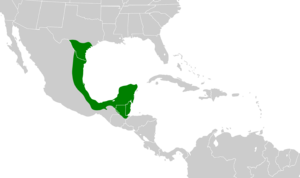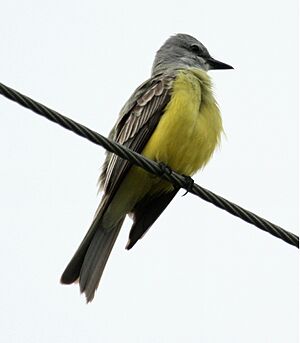Couch's kingbird facts for kids
Quick facts for kids Couch's kingbird |
|
|---|---|
 |
|
| Conservation status | |
| Scientific classification | |
| Genus: |
Tyrannus
|
| Species: |
couchii
|
 |
|
The Couch's kingbird (Tyrannus couchii) is a cool bird that belongs to the tyrant flycatcher family. It's a type of passerine bird, which means it's a perching bird. You can find this bird in southern Texas, along the Gulf Coast, and down to the Yucatán Peninsula in Mexico, Belize, and northern Guatemala. It also lives in the lower parts of the Lower Rio Grande Valley.
This bird is named after Darius N. Couch, who was a soldier and a naturalist.
Contents
What Does the Couch's Kingbird Look Like?
Couch's kingbird is about 7 inches long. That's about the length of a standard pencil! It has a big head and a strong bill. Its tail is dark and looks forked, like a 'V' shape.
The bird's head is a light gray color. Its cheeks are a bit darker, which makes them stand out. The top part of its body is grayish-olive. It has a pale throat and a darker chest. The lower part of its chest is a bright yellow. Young Couch's kingbirds have browner underparts than the adults. They also have light edges on their wings.
How to Tell Couch's Kingbird Apart from Similar Birds
Couch's kingbird can be tricky to identify. It looks very much like the tropical kingbird (T. melancholicus). In fact, for a long time, people thought they were the same bird! The best way to tell them apart is by listening to their calls. The Couch's kingbird has a rougher, more complex call. Its call also changes pitch more often.
Another clue is where they live. Couch's kingbirds prefer more wooded areas. Tropical kingbirds, on the other hand, like more open spaces.
Cassin's kingbird (T. vociferans) can also look similar. But Cassin's kingbird has a darker head. It also has white tips on its outer tail feathers. The western kingbird (Tyrannus verticalis) is another similar bird. Western kingbirds have white outer tail feathers, like Cassin's kingbirds. They also have a gray area on their chest that extends down from their head. Couch's kingbirds do not have this gray chest patch.
Where Do Couch's Kingbirds Live?
Couch's kingbirds are native to several places. These include southern Texas, eastern Mexico, Belize, and northeastern Guatemala. They like to live in lightly wooded areas. This means places with some trees, but not super dense forests.
You can find them in sparse forests, suburban areas, and thorn forests. They also like the edges of wooded streams. These birds often live near water, especially rivers. You might even spot them near roadsides and forest edges.
Once, a Couch's kingbird was seen far from its usual home. This happened in New York City in December 2014. It was a rare sighting that got many birdwatchers excited!
Couch's Kingbird Behavior and Habits
What Do Couch's Kingbirds Eat?
Couch's kingbirds mostly eat insects. This makes them insectivores. They enjoy larger insects like beetles, grasshoppers, wasps, and big flies. Sometimes, they also eat small berries and seeds. This means they can also be frugivores.
These birds are good hunters. They usually perch on a branch and watch for insects. When they spot prey, they fly out to catch it in mid-air. They might hover above the insect or quickly swoop down. After catching their meal, they fly back to a branch to eat it.
How Do Couch's Kingbirds Reproduce?
Scientists don't know every detail about how Couch's kingbirds nest. However, it's thought to be similar to the tropical kingbird. They like to build their nests in lightly wooded areas. They often choose trees like sugar hackberry, cedar elm, Texas ebony, and Mexican ash.
The nest is usually flat and shaped like a cup. It's believed that the female bird builds it. Nests are made from twigs, leaves, weeds, moss, and bark. The inside is lined with soft materials. These include rootlets, plant down, and Spanish moss.
Nests are built horizontally on higher branches. They are usually 8 to 25 feet above the ground. The adult birds are very protective of their nest. They will chase away larger birds to keep their eggs safe.
The female bird sits on the eggs to keep them warm. This is called incubation. The incubation period is not precisely known. But it's estimated to be a little over two weeks. A female can lay up to five eggs. However, most nests have three or four eggs. The eggs are a pinkish-warm buff color. They have darker brown and lavender spots.
It's believed that both parents help feed the young birds. But more research is needed to confirm this. The young birds usually take their first flight when they are about 2 to 3 weeks old.
Are Couch's Kingbirds in Danger?
The Couch's kingbird is not considered to be in danger. Its conservation status is listed as "least concern." This means their population seems to be growing.
In Texas, the number of Couch's kingbirds is stable. However, in Mexico, their population changes. This is due to cities growing and forests being cut down.



